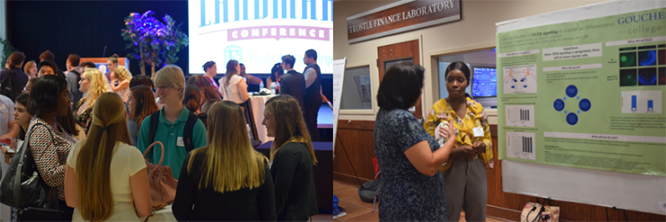Location
Poster Presentations
Department
Chemistry and Biochemistry
Start Date
11-7-2019 2:45 PM
End Date
11-7-2019 3:45 PM
Description
The majority of information known about RNA is centered around coding RNA for its role in synthesizing proteins from DNA. However, noncoding RNA is also biologically relevant, showing importance in gene expression and catalyzing reactions. Peptide Nucleic Acids, or PNAs, are a promising tool that can be used to study noncoding RNA. PNAs can bind to double-stranded RNA forming a triple helix and are highly selective for specific sequences of dsRNA. A current limitation of PNA as a ligand is that traditional nucleobases only bind with high affinity to single purine residues on the RNA, as triplex formation relies on the two hydrogen bonding sites offered by purines as opposed to only one offered by pyrimidines. More recent developments in our group and others have shown that synthetic nucleobases may be used to increase both affinity and selectivity. We have synthesized a uracil nucleobase modified to bind both the adenine and the uracil of the A-U base pair by adding a benzamide moiety to isoorotic acid. Computations suggest that this will increase the affinity of binding and make PNA relevant for use in dsRNA sequences containing both purine and pyrimidine bases.
Recommended Citation
Talbott, John M. and Maryniak, Aubrey L., "Synthesis of an Amide-Based Extended Heterocyclic System Capable of Hydrogen Bonding to Both the Adenine and Uracil in dsRNA for RNA Recognition Using PNA" (2019). Landmark Conference Summer Research Symposium. 10.
https://jayscholar.etown.edu/landmark/2019/july11/10
Synthesis of an Amide-Based Extended Heterocyclic System Capable of Hydrogen Bonding to Both the Adenine and Uracil in dsRNA for RNA Recognition Using PNA
Poster Presentations
The majority of information known about RNA is centered around coding RNA for its role in synthesizing proteins from DNA. However, noncoding RNA is also biologically relevant, showing importance in gene expression and catalyzing reactions. Peptide Nucleic Acids, or PNAs, are a promising tool that can be used to study noncoding RNA. PNAs can bind to double-stranded RNA forming a triple helix and are highly selective for specific sequences of dsRNA. A current limitation of PNA as a ligand is that traditional nucleobases only bind with high affinity to single purine residues on the RNA, as triplex formation relies on the two hydrogen bonding sites offered by purines as opposed to only one offered by pyrimidines. More recent developments in our group and others have shown that synthetic nucleobases may be used to increase both affinity and selectivity. We have synthesized a uracil nucleobase modified to bind both the adenine and the uracil of the A-U base pair by adding a benzamide moiety to isoorotic acid. Computations suggest that this will increase the affinity of binding and make PNA relevant for use in dsRNA sequences containing both purine and pyrimidine bases.




Comments
Faculty mentor: James MacKay, Elizabethtown College.